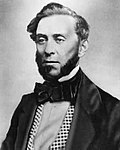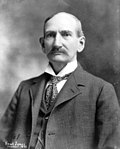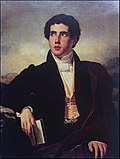The California gold rush occurred in Northern California, during the period from 1848 to 1855.
| Name | Image | Birth, death | Birthplace | Profession | Notes |
|---|---|---|---|---|---|
| John "Grizzly" Adams |  | 1812–1860 | Medway, Massachusetts, U.S. | mountain man, trainer of grizzly bears | [1] |
| Elihu Anthony |  | 1818–1905 | Greenfield, New York, U.S. | alcalde , blacksmith, industrialist, abolitionist, postmaster, Methodist minister | one of the founding fathers of the city of Santa Cruz, California [2] |
| Philip Danforth Armour |  | 1832–1901 | Stockbridge, New York, U.S. | meatpacking industrialist | started his meat packing business with funds from success in the Gold Fields [3] |
| Josiah Belden |  | 1815–1892 | Connecticut, U.S. | politician, rancho grantee | first mayor of San Jose, California |
| Charles H. Bennett | 1811–1855 | Walla Walla, Washington, U.S. | soldier, hotelier | present at the first discovery of gold | |
| John Bidwell |  | 1819–1900 | Chautauqua County, New York, U.S. | politician, soldier | founder of the city of Chico, California |
| Samuel Brannan |  | 1819–1889 | Saco, Massachusetts (now Maine), U.S. | politician, businessman, journalist | first to publicize the California Gold Rush, and California's first millionaire |
| Juana Briones de Miranda |  | c. 1802 – 1889 | Villa de Branciforte (modern day Santa Cruz), California | Californio ranchera, medical practitioner, merchant | founding mother of San Francisco, California, and Mayfield, California (now Palo Alto, California) [4] [5] |
| R. C. Chambers |  | 1832–1901 | Lexington, Ohio, U.S. | businessman, politician, minerals miner, banker | |
| Jean Baptiste Charbonneau | 1805–1866 | Fort Mandan, North Dakota, U.S. | Shoshone–French explorer, guide, fur trapper, and military scout | ||
| Alvin Aaron Coffey Sr. |  | 1822–1902 | Mason County, Kentucky, U.S. | African American pioneer, homesteader, miner, and farmer in California; formerly enslaved | [6] [7] |
| Belle Cora | c. 1827–1862 | Baltimore, Maryland, U.S. | madam of the Barbary Coast of San Francisco | [8] | |
| Lotta Crabtree |  | 1847–1924 | New York City, New York, U.S. | actress, entertainer, comedian, philanthropist | [9] |
| William D. Bradshaw | 1826–1864 | Buncombe County, North Carolina, U.S | prospector, explorer | ||
| Charles Crocker |  | 1822–1888 | Troy, New York, U.S. | railroad executive, businessman | |
| Alonzo Delano |  | 1806–1874 | Aurora, Erie County, New York, U.S. | writer, forty-niner | |
| George Washington Dennis | c. 1825–1916 | Mobile County, Alabama, U.S. | African American businessperson, real estate developer, abolitionist | one of San Francisco's wealthiest Black men in the late 19th-century | |
| Charles S. Fairfax |  | 1829–1869 | Vaucluse Plantation, Virginia, U.S. | politician | from nobility |
| Thomas Fallon |  | 1825–1885 | Ireland | Irish-born politician | 10th Mayor of San Jose, California |
| Joseph Libbey Folsom |  | 1817–1855 | Meredith, New Hampshire, U.S. | real estate investor, military personnel | founder of Folsom, California |
| John C. Frémont |  | 1813–1890 | Savannah, Georgia, U.S. | explorer, military officer, politician | namesake of Fremont, California |
| John White Geary |  | 1819–1873 | Westmoreland County, Pennsylvania, U.S. | lawyer, politician, military leader | |
| Domingo Ghirardelli |  | 1817–1894 | Rapallo, Kingdom of Sardinia (now Italy) | Italian-born chocolatier | founder of the Ghirardelli Chocolate Company in San Francisco, California. |
| Mifflin Wistar Gibbs |  | 1823–1915 | Philadelphia, Pennsylvania, U.S. | African American politician, businessman, publisher, abolitionist | During the Fraser Canyon Gold Rush, he led a migration of African Americans from San Francisco to Victoria, British Columbia, Canada |
| Thomas Gilman |  | 1830–1911 | Tennessee, U.S. | African American freedman, miner, farmer | was an enslaved African American who self–purchase freedom during the mid-19th-century |
| George Gordon |  | 1818–1869 | London, England | developer, entrepreneur | transported emigrants to San Francisco, developed the South Park neghborhood, started San Francisco's first sugar refinery |
| Daniel Govan |  | 1829–1911 | Northampton County, North Carolina, U.S. | miner, planter, soldier | served as a Confederate general during the American Civil War |
| Ulysses S. Grant |  | 1822–1885 | Point Pleasant, Ohio, U.S. | 18th president, soldier | served in the Mexican–American War; led the Union Army to victory in the American Civil War |
| Alvinza Hayward |  | 1821–1904 | Vermont, U.S. | mine-owner, capitalist, businessman, financier | made his fortune during the California Gold Rush, as a gold miner |
| George Hearst |  | 1820–1891 | Sullivan, Missouri Territory (now Missouri), U.S. | businessperson, politician | used slight mining knowledge from Missouri to succeed in 1850s gold rush investment |
| Albert W. Hicks |  | c. 1820–1860 | Foster, Rhode Island, U.S. | thief, murderer, mutineer, pirate | |
| Frederick A. Hihn |  | 1829–1913 | Duchy of Brunswick (now Germany) | politician, industrialist, real estate investor | leading land developer in Santa Cruz County, California |
| John Wesley Hillman | 1832–1915 | Albany, New York, U.S. | prospector, explorer | ||
| Sherman Otis Houghton |  | 1828–1914 | New York City, New York, U.S. | politician, miner | |
| William B. Ide |  | 1796–1852 | Rutland, Massachusetts, U.S. | politician | commander of the California Republic |
| Frank James |  | 1843–1915 | Kearney, Missouri, U.S. | soldier, thief | part of the James–Younger Gang, former Confederate soldier |
| Seth Kinman |  | 1815–1888 | Union County, Pennsylvania, U.S. | mountain man, hunter, chair maker, entertainer | early settler of Humboldt County, California |
| William Leidesdorff |  | 1810–1848 | St. Croix, Danish West Indies (now United States Virgin Islands) | Afro-Caribbean businessman, politician | founder of the city of San Francisco, thought to have been the first black millionaire in the United States [10] [11] |
| Peter Lester |  | c. 1814–c. 1897 | South Carolina, U.S. | African American businessman, abolitionist | early Black settler in San Francisco |
| James Lick |  | 1796–1876 | Stumpstown (now Fredericksburg), Lebanon County, Pennsylvania, U.S. | businessman, piano builder | |
| Heinrich Lienhard |  | 1822–1903 | Bilten, Canton of Glarus, Switzerland | Swiss–born memoirist | |
| James W. Marshall |  | 1810–1885 | Hopewell Township, New Jersey, U.S. | carpenter, sawmill operator | discoverer of the first gold |
| Richard Barnes Mason |  | 1797–1850 | Lexington Plantation, Fairfax County, Virginia, U.S. | military officer | |
| Lola Montez |  | 1821–1861 | Grange, County Sligo, Connacht, Ireland | Irish-born dancer and courtesan | famous as a "Spanish" dancer, and mistress of King Ludwig I of Bavaria [12] |
| James McClatchy | 1824–1883 | Ireland | Irish-born newspaper editor | ||
| Benjamin McCulloch |  | 1811–1862 | Rutherford County, Tennessee, U.S. | politician | |
| Joaquin Miller |  | 1837–1913 | Union County, Indiana, U.S. | poet, frontiersman | |
| Joaquin Murrieta |  | 1829–1853 | Álamos, Sonora, Mexico | Mexican outlaw, gold miner, vaquero | "Robin Hood of the West" |
| Isaac Murphy |  | c. 1799–1882 | Pennsylvania, U.S. | teacher, lawyer, politician, failed miner | 8th Governor of Arkansas |
| Joshua Norton |  | 1818–1880 | Deptford, England | English-born commodities trader and real estate investor | also known as Emperor Norton |
| Lester Allan Pelton |  | 1829–1908 | Vermilion, Ohio, U.S. | inventor, mechanical engineer | inventor of the "Pelton Runner," considered to be the "Father of Hydroelectric Power" |
| Vicente Pérez Rosales |  | 1807–1886 | Santiago, Chile. | miner, merchant, politician, writer, forty-eighter | wrote an influential text about the gold rush, led later the German colonization of southern Chile |
| Pío Pico |  | 1801–1894 | Mission San Gabriel Arcángel, San Gabriel, Alta California, New Spain | Californio politician, ranchero, entrepreneur | last governor of Alta California under Mexican rule from 1845 to 1846. [13] [14] |
| Mary Ellen Pleasant |  | c. 1814–1904 | U.S. | African American entrepreneur, real estate investor, abolitionist, financier | first self-made millionaire of African-American heritage |
| Addison Pratt |  | 1802–1872 | Winchester, New Hampshire, U.S. | missionary, farmer, whaler | |
| José Manuel Ramírez Rosales |  | 1804–1877 | Santiago, Chile. | miner, vine and watermelon farmer, painter | introduced Chilean grapes to California |
| Benjamin B. Redding |  | 1824–1882 | Yarmouth, Colony of Nova Scotia (now Nova Scotia, Canada) | British North America-born politician | Mayor of Sacramento, secretary of the State of California |
| Moses Rodgers | c. 1835–1900 | Missouri, U.S. | African American mining engineer, metallurgist | ||
| John Howell Sears | 1823–1907 | Sullivan County, New York, U.S. | prospector | early pioneer of Searsville and La Honda [15] | |
| William Tecumseh Sherman |  | 1820–1891 | Lancaster, Ohio, U.S. | soldier, businessman, educator, author | |
| Leland Stanford |  | 1824–1893 | Watervliet, New York, U.S. | politician, railroad tycoon | |
| Elijah Steele |  | 1817–1883 | New York, U.S. | politician, attorney, jurist | |
| Levi Strauss |  | 1829–1902 | Buttenheim, Kingdom of Bavaria, German Confederation (now Germany) | German Confederation-born entrepreneur | founder of Levi Strauss & Co. of San Francisco, California |
| John Studebaker |  | 1833–1917 | Gettysburg, Pennsylvania, U.S. | businessman | built wheelbarrows in Placerville in the early 1850s and contributed his earnings to the family Studebaker Wagon Corporation |
| Marie Suize | 1824–1892 | Savoy, France | French-born gold miner and businesswoman | known for wearing pants, and arrested several times for it. | |
| John Sutter |  | 1803–1880 | Kandern, Margraviate of Baden, Holy Roman Empire (now Germany) | German-born Swiss businessman, explorer | established Sutter's Fort |
| A. A. Townsend |  | 1810–1888 | Sussex County, New Jersey, U.S. | miner, prospector, politician | |
| Ah Toy | 1829–1928 | Canton, Guangdong, Qing China | sex worker, madam | the first Chinese sex worker in San Francisco | |
| George Treat | 1819–1907 | Frankfort, Maine, U.S. | businessman, abolitionist | pioneer in the Mission District, San Francisco | |
| Matthew Turner |  | 1825–1909 | Geneva, Ohio, U.S. | shipbuilder | considered "the 'grandaddy' of big time wooden shipbuilding on the Pacific Coast" |
| Mark Twain |  | 1835–1910 | Florida, Missouri, U.S. | writer, humorist, and essayist | |
| Mariano Guadalupe Vallejo |  | 1807–1890 | Monterey, Alta California, Viceroyalty of New Spain (now California, U.S.) | Californio politician, military leader | |
| William Waldo |  | 1812–1881 | politician | ||
| Carl David Maria Weber |  | 1814–1881 | Steinwenden, Palatinate, Kingdom of Bavaria (now Rhineland-Palatinate, Germany) | entrepreneur, miner, land owner | founder of the city of Stockton, California |
| Bela Wellman | 1819–1887 | entrepreneur | founder of Wellman, Peck and Company | ||
| Luzena Wilson | c. 1820–1902 | entrepreneur | founder of the El Dorado hotel in Nevada City | ||
| Edwin B. Winans |  | 1826–1894 | politician |